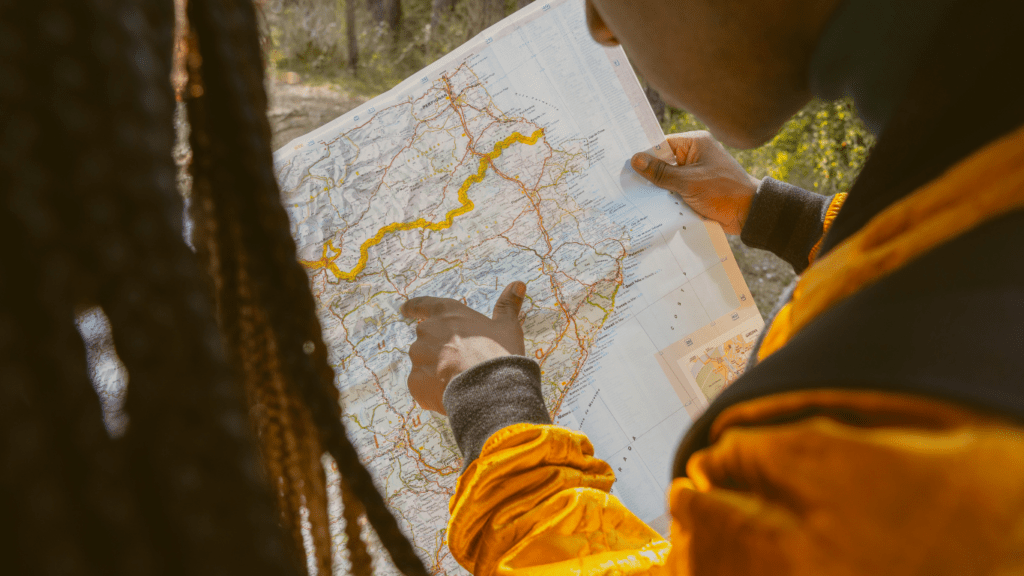Importance Of Understanding Trail Maps
Understanding trail maps is crucial for outdoor safety. Proper knowledge of map reading ensures hikers don’t get lost. Maps highlight trails, landmarks, and potential hazards, making navigation easier.
Trail maps offer details on terrain types, elevation changes, and distances. This information helps in planning hikes based on one’s fitness level. For example, steep elevation gains can be identified early, allowing one to prepare adequately.
Emergency situations require quick decision-making. Knowing how to interpret trail maps can help locate the nearest exit points or shelters. This knowledge is essential during adverse weather conditions or injuries.
Trail maps often feature symbols for various amenities. Facilities like restrooms, water sources, and campsites are usually marked. Familiarizing oneself with these symbols enhances the hiking experience.
Modern trail maps might include GPS coordinates. These are invaluable for precision in navigation. Even if using digital maps, a basic understanding of traditional trail maps provides a reliable backup.
Mastering trail map reading builds confidence. It transforms hiking into a safer, more enjoyable adventure. By understanding maps, one can focus on the beauty of nature without constant worry about losing their way.
Types Of Trail Maps
Understanding different types of trail maps is essential for safe and enjoyable hiking. Each type of map serves a unique purpose and offers various benefits to hikers.
Topographic Maps
Topographic maps represent the terrain using contour lines, showing elevation changes and landscape features. These maps highlight peaks, valleys, rivers, and trails, making them invaluable for understanding the geography of an area. By reading these maps, I can gauge the difficulty of a hike and plan accordingly. For example, if I see tightly spaced contour lines, I know the terrain is steep.
Digital Maps
Digital maps offer real-time navigation aid through GPS technology. Available on smartphones and GPS devices, they provide up-to-date information on trail conditions and coordinates. I appreciate the convenience of zooming in for detailed views and accessing trailhead information. Apps like AllTrails and Gaia GPS have become indispensable tools for tracking my location and planning routes.
Paper Maps
Paper maps serve as reliable backups in areas with limited or no cell signal. They’re durable and don’t depend on battery life, which is crucial during long hikes. I usually carry a waterproof paper map of the trail for reference. These maps often contain detailed trail information, points of interest, and safety tips, enhancing preparedness for unforeseen events.
Essential Features Of Trail Maps
Understanding essential features of trail maps turns confusion into clarity. These key elements ensure a safe and enjoyable hiking experience.
Contour Lines
Contour lines indicate elevation changes on a trail map. Closely spaced lines signal steep terrain, while widely spaced lines denote gentle slopes. Knowing this helps plan hikes according to fitness levels and trail difficulty.
Symbols And Legends
Symbols and legends provide crucial information. Icons represent amenities like:
- water sources
- restrooms
- shelters
Legends decode these symbols, ensuring quick comprehension and aiding navigation.
Scale And Distance
Scale and distance markers convert map distances into real-world measurements. A 1:24,000 scale means 1 inch on the map equals 24,000 inches in reality. This helps estimate travel time and map out day hikes.
Navigational Tools And Techniques

Navigating trails requires more than just knowing how to read a map. Using the right tools and techniques ensures safety and confidence while hiking.
Compass Usage
A compass is a crucial tool for navigating the wilderness. It helps determine direction relative to the Earth’s magnetic poles. To use a compass, align the edge of the compass with the map’s orientation lines, then rotate the map and compass together until the needle points north. This method, known as “orienting the map,” allows easy navigation. Always recalibrate the compass periodically to account for magnetic declination, which varies by location.
GPS Devices
GPS devices provide precise location data by connecting to satellites. These devices offer real-time navigation, track routes, and provide elevation data. Popular models like the Garmin GPSMAP series are rugged and reliable. To use a GPS device effectively in the backcountry, ensure it’s preloaded with trail maps, and double-check batteries and signal strength before setting out. Mark waypoints along the trail as reference points in case you need to backtrack.
Map Apps
Smartphone apps combine traditional maps with modern technology, offering a dynamic navigation experience. Apps like AllTrails and Gaia GPS provide detailed trail maps, user-uploaded reviews, and up-to-date trail conditions. Ensure offline maps are downloaded to your device to account for areas with poor cell signal. Use the app’s tracking features to monitor progress and compare it with your pre-planned route.
These navigational tools and techniques complement each other, creating a holistic approach to outdoor navigation. Combining them with proper map-reading skills transforms trail navigation into a reliable and enjoyable part of the hiking adventure.
Common Mistakes And How To Avoid Them
Many hikers make errors when interpreting trail maps. Recognizing these common mistakes can significantly improve navigation skills and enhance outdoor adventures.
Misreading Contour Lines
- Contour lines indicate elevation changes on a map.
- Misreading these lines can lead to underestimating a trail’s difficulty.
- Closely spaced lines signify steep terrain, while widely spaced lines denote gentle slopes.
- Always check the contour interval to understand the elevation change accurately.
- A map with a 10-meter interval means each line represents a 10-meter change in elevation.
Ignoring The Legend
The legend decodes symbols and colors used on a trail map. Ignoring the legend can lead to confusion about features like trail difficulty, water sources, or hazard zones. A red dashed line might indicate a strenuous trail, while a blue line usually shows a water body. Spend a few minutes reviewing the legend before starting your hike to avoid misinterpretations.
Overlooking Important Details
Details like trail intersections, distance markers, and scale are critical for accurate navigation. Overlooking them can result in missed turns or extended hikes. For instance, a 1:25,000 scale means 1 inch on the map equals 25,000 inches in reality. Pay close attention to these specifics to plan hydration and breaks effectively. Always cross-reference these details with your current location to stay on course.
Practical Tips For Staying On Track
Reading a trail map correctly is just one part of staying on track while hiking. The following practical tips will help ensure you don’t veer off course.
Regularly Check Your Position
I find it crucial to frequently check my position against the map. This habit helps me confirm that I’m still on the designated trail. Every 15-30 minutes, I stop and compare the terrain around me with the map’s features. This way, I can quickly identify if I’ve deviated from my planned path and make the necessary adjustments.
Plan Your Route In Advance
Before starting my hike, I thoroughly plan my route. I review the entire trail, noting important junctions, elevation changes, and stopping points. I also decide on approximate times I expect to reach specific landmarks. This preparation gives me a clear mental image of the trail, reducing chances of confusion or getting lost.
Stay Aware Of Landmarks
While hiking, I stay vigilant for significant landmarks. These include large rock formations, streams, and trail junctions that match the map’s details. Noticing these landmarks reassures me that I’m on the right track and helps me to pinpoint my exact location on the map.
By incorporating these practices into my hikes, I’ve significantly decreased the risk of getting lost and increased my overall enjoyment of the outdoor adventure.



 Hiking Trail Guide Expert & Outdoor Adventure Curator
Keturaha Perrymaners is an experienced trail guide and hiking enthusiast with an unparalleled passion for discovering and exploring nature’s most beautiful and secluded paths. As the hiking trail expert at Whisper Forest Ways, Keturaha curates comprehensive guides that cover everything from beginner-friendly walks to challenging multi-day treks. Her deep knowledge of terrain, weather patterns, and outdoor safety ensures that her recommendations cater to hikers of all levels, helping them prepare for their adventures with confidence. Whether you’re seeking scenic trails for mindfulness walks or rugged paths for a physical challenge, Keturaha’s expertly crafted guides provide the insights and inspiration you need to venture into the wilderness and fully immerse yourself in nature’s beauty.
Hiking Trail Guide Expert & Outdoor Adventure Curator
Keturaha Perrymaners is an experienced trail guide and hiking enthusiast with an unparalleled passion for discovering and exploring nature’s most beautiful and secluded paths. As the hiking trail expert at Whisper Forest Ways, Keturaha curates comprehensive guides that cover everything from beginner-friendly walks to challenging multi-day treks. Her deep knowledge of terrain, weather patterns, and outdoor safety ensures that her recommendations cater to hikers of all levels, helping them prepare for their adventures with confidence. Whether you’re seeking scenic trails for mindfulness walks or rugged paths for a physical challenge, Keturaha’s expertly crafted guides provide the insights and inspiration you need to venture into the wilderness and fully immerse yourself in nature’s beauty.
